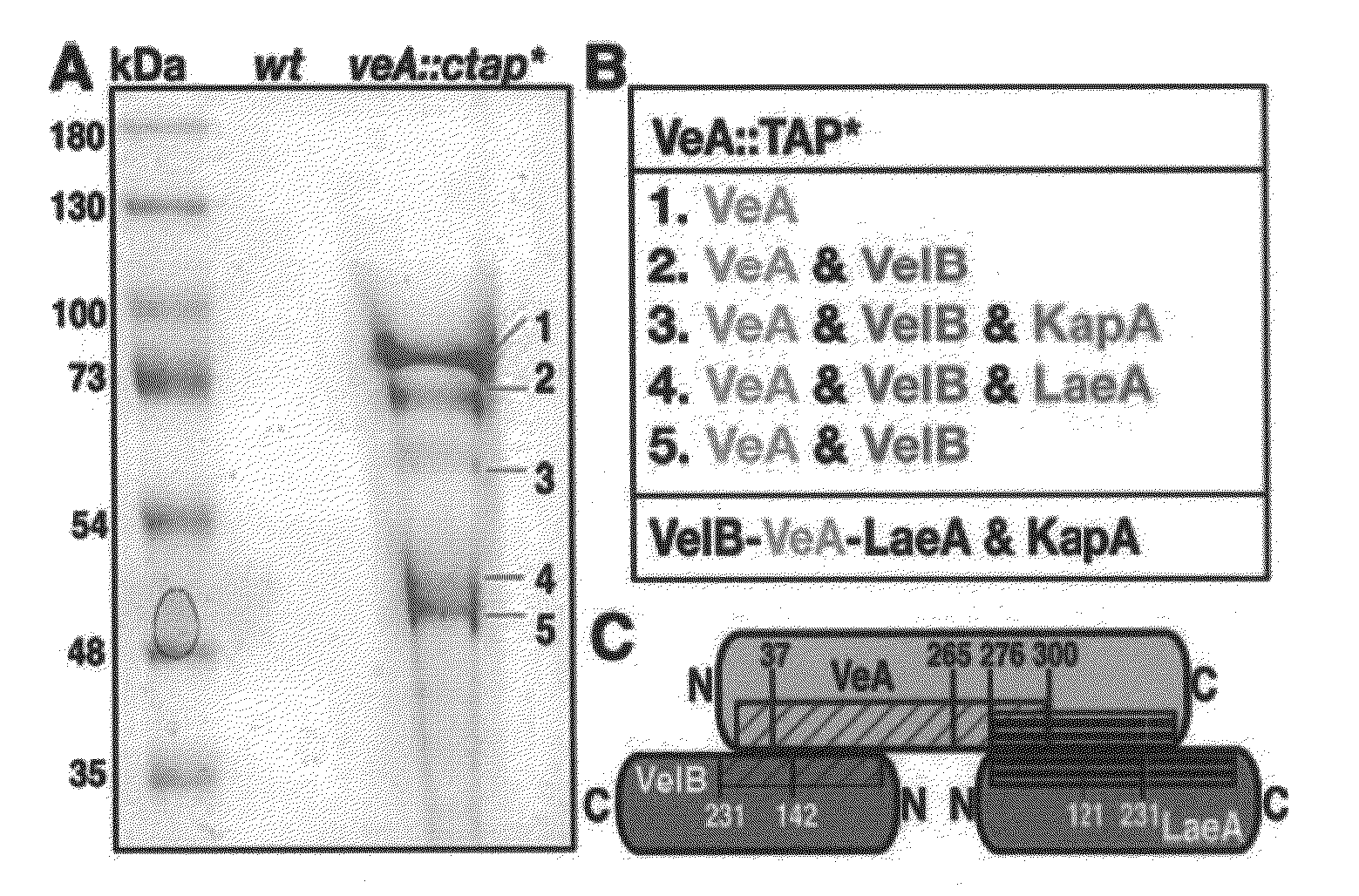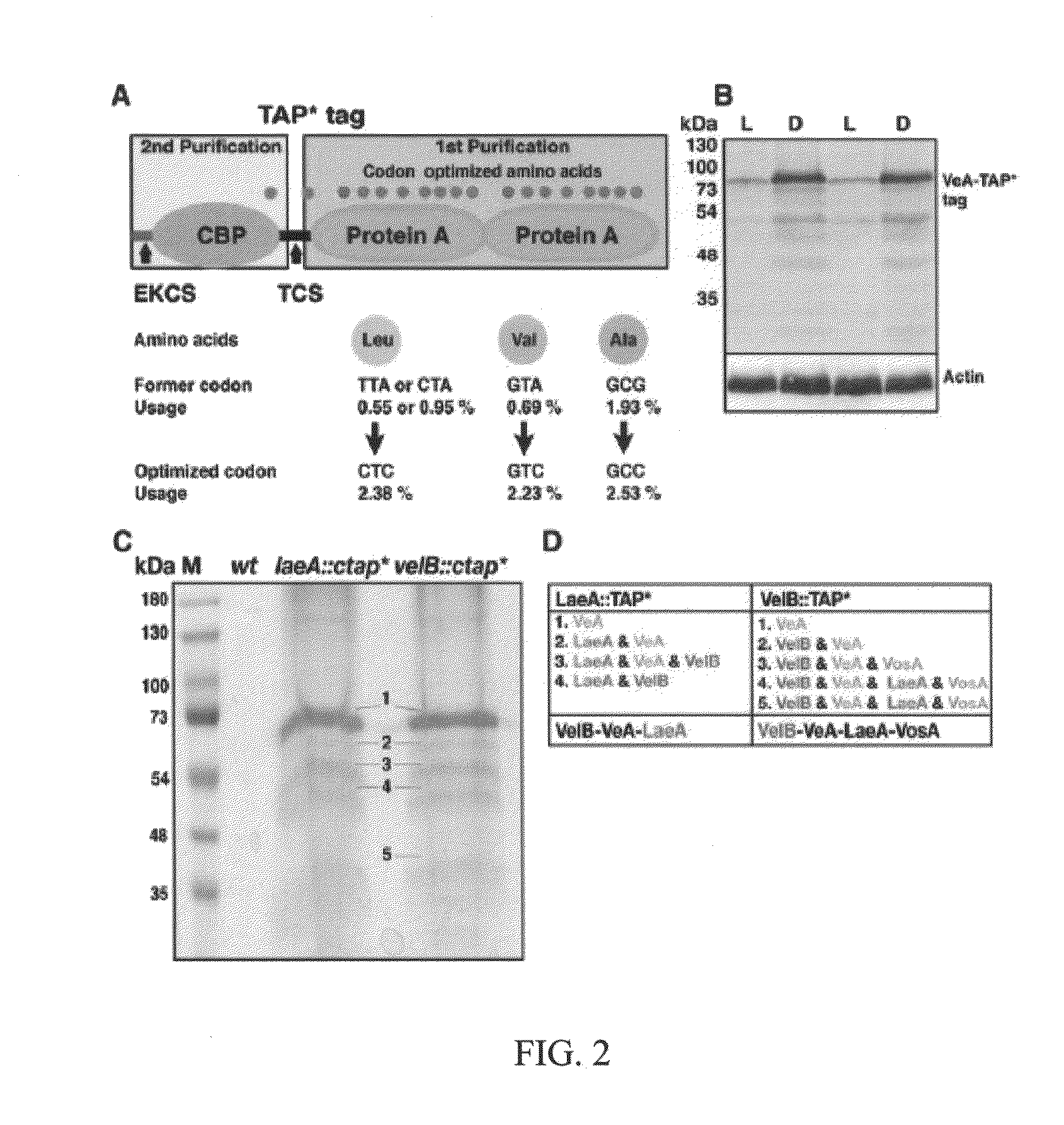Over-production of secondary metabolites by over-expression of the VEA gene
a technology of vea and secondary metabolites, which is applied in the direction of peptides, microorganisms, peptide/protein ingredients, etc., can solve the problems of difficult methods of producing large amounts of secondary metabolites, high toxic carcinogens contaminating many crops, and defects in fungal development, so as to reduce the production of secondary metabolites, and increase the amount of secondary metabolites
- Summary
- Abstract
- Description
- Claims
- Application Information
AI Technical Summary
Benefits of technology
Problems solved by technology
Method used
Image
Examples
example 1
[0108]In the present invention, tandem affinity purification (TAP) was used to identify VeA-interacting proteins (FIG. 1A and FIG. 2A). Final eluates of dark- and light-grown A. nidulans carrying the functional veA gene tagged at its C terminus by TAP tag (veA::ctap*) were analyzed by mass spectrometry. The velvet-like protein B (VelB) (FIG. 3A, 3B), the regulator LaeA, and the α importin KapA were identified as proteins that interact with VeA in the dark (FIG. 1B and Table 4). (Importin is a type of protein that moves other protein molecules into the nucleus by binding to a specific recognition sequence, called the nuclear localization signal (NLS)).
[0109]In the light, tagged VeA protein is hardly expressed (FIG. 2B) and only copurifies with VelB. Reciprocal affinity purifications of tagged VelB and LaeA in the dark confirmed the interaction partners, except for the α importin KapA (FIGS. 2C and D). Only tagged VelB can additionally recruit the regulator of sporogenesis VosA in the...
example 2
[0155]In this example, the inventors created several A. flavus isogenic mutants differing only in copy number of veA and laeA genes, including ΔveA, ΔlaeA, multicopy laeA (MClaeA), and MCveA strains and a double MC strain (MCveA-laeA). The respective VeA and LaeA mutants exhibited critical differences in cell density responses and invasion of host tissues, despite gross similarities between sclerotial and aflatoxin production.
[0156]Considering the interdependence of oxylipin function with VeA coupled with the VeA-LaeA interaction, we postulated that VeA mutants would also be impaired in seed pathogenesis in a manner similar to that of LaeA mutants and, furthermore, that both mutants could be affected in density-dependent development. To explore these hypotheses, we created several A. flavus isogenic mutants differing only in copy number of veA and laeA genes, including ΔveA, ΔlaeA, multicopy laeA (MClaeA), and MCveA strains and a double MC strain (MCveA-laeA). The respective VeA and...
PUM
| Property | Measurement | Unit |
|---|---|---|
| time points | aaaaa | aaaaa |
| time points | aaaaa | aaaaa |
| Tm | aaaaa | aaaaa |
Abstract
Description
Claims
Application Information
 Login to View More
Login to View More - R&D
- Intellectual Property
- Life Sciences
- Materials
- Tech Scout
- Unparalleled Data Quality
- Higher Quality Content
- 60% Fewer Hallucinations
Browse by: Latest US Patents, China's latest patents, Technical Efficacy Thesaurus, Application Domain, Technology Topic, Popular Technical Reports.
© 2025 PatSnap. All rights reserved.Legal|Privacy policy|Modern Slavery Act Transparency Statement|Sitemap|About US| Contact US: help@patsnap.com



